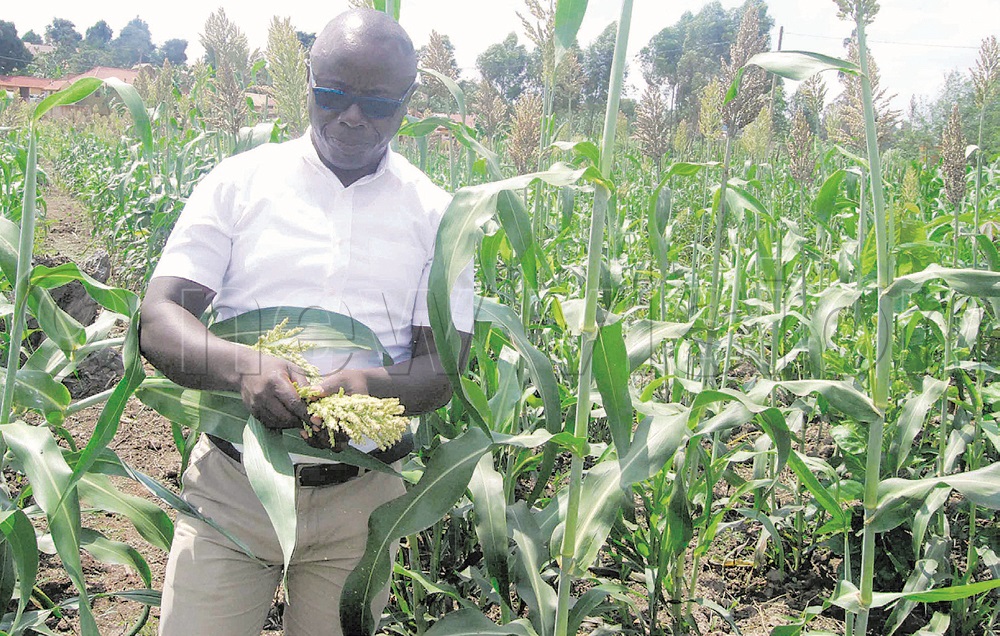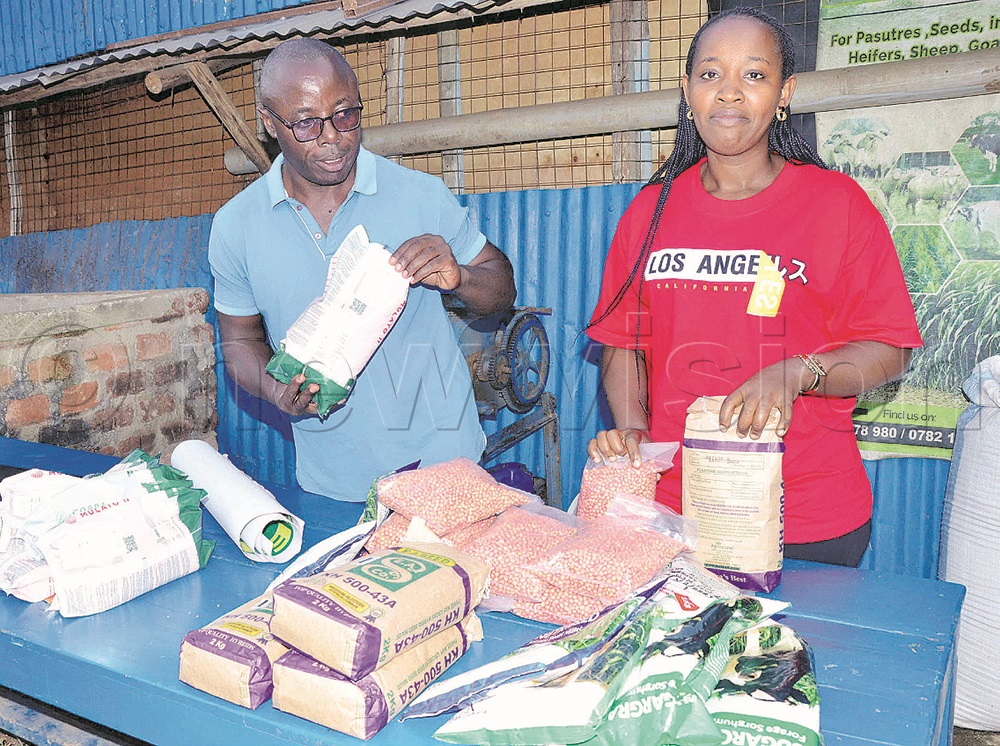By Herbert Musoke
While farming is a venture where the hope of a good return is certain, it is imperative for one to seek a thorough understanding of what it takes to have a successful farm.
This is a lesson Pison Busingye had to learn the hard way after losing six of the eight heifers he bought to start a dairy farm at Namayumba in Wakiso district.
He recalls that all he had was passion and no knowledge. He even did not visit any other farms to learn how to successfully manage the enterprise and relied solely on the workers at the farm.
“Passion is not enough for one to build a successful farm. You need to take time to study an enterprise before venturing into it. In addition, you also have to continue learning which is a process,” he says.

Busingye and his wife, Jolly Asiimwe, are the directors of Itungo Pastures located at Kyoga in Wakiso district.
Their enterprises at the farm which sits on three acres include pasture growing, selling in-calf heifers, aquaculture and fabricating agro machinery, especially forage choppers.
Learning the hard way
Busingye started farming in 2016 with eight heifers that he bought from Mbarara and took to Namayumba in Wakiso district. The area was bushy and six of the heifers died of tick fever.
“That same year, New Vision organised a training about animal feeding at Dr Jolly Kabirizi’s Kyakuwa Dairy farm at Sseguku, which I attended. I learnt that to succeed in dairy farming, one needs quality pasture,” he says.
He adds that he learnt about paying attention to nutritional value because what you feed your animal on plays a big role and determines its productivity.
“Feed accounts for 70% of the cost in livestock management. Pasture contributes the biggest percentage of animal feed. To get the best out of your animal farm, you need to feed your them on quality pastures,” he says.

As he sought her advice, Kabirizi took Busingye through the best animal care practices, that is, feeding, health, proper housing and waste management, among others.
Busingye explains that he decided to venture into growing pasture, starting with Russian comfrey, and constructed a good animal house. He also bought four heifers whose production was good.
The birth of Itungo pastures
Busingye is a salesperson. Before venturing into farming, he worked as a sales executive, but he wasn’t earning enough to ably cater for the family.
He then started his own business that he believed would pay him well. He opted for agriculture, as his dream was dairy farming, and bought eight acres of land at Namayumba in 2013.
Each acre was sh4m each.
“I started with selling in-calf heifers in 2016,” he says.
At this time, he had not visited any farmer nor taken the time to read and understand what is required of him to manage and make a dairy farm successful.
“In 2018, during the Pakasa business training organised by Vision Group, the guest speaker, Aga Sekalaala, advised us that as an investor, youshould sleep where your money is. At that time, we were staying in Munyonyo, so we had to shift to Wakiso where our farm is.”
Busingye says this is when real business started and that they registered their farm in 2019.
It is then that Itungo Pastures was officially born and, in 2020 during the COVID-19 pandemic when many people ventured into farming, they broke even and started making profits.
Dealing in heifers
With time, they diversified into sellingquality in-calf heifers. To ensure their health, Busingye says they have a veterinary doctor who checks the health and gestation of the animals before they are sold to farmers. “We get these heifers through our dairy farmers’ association and the money is deposited on the body’s account and we are given the commission,” Busingye notes.
“Because most of the farmers in the western side of the country where we get most heifers from are free range grazers, we train these heifers to get used to zero grazing before we givethem to farmers.”
He says many farmers were looking for good breeds, but did not know where to get them and that others had been cheated by buying poor quality breed animals expensively.
They sell to individual farmers, institutions such as, Kabanyoro, Makerere University and the National Agricultural Research Organisation, among others.
Growing pastures
Busingye says in addition to what they had learnt from Kabirizi, they sought more knowledge about pasture growing and now have two-and-a-half acres of pasture.
“In the process, I learnt that before introducing the animals on the farm, one needs to grow enough nutritious pastures and also store some as hay and silage,” he says.
The majority of Uganda’s farmers believe that growing pastures simply means elephant grass, which is wrong. Such grass only fills the animal’s stomach, but lacks sufficient nutrients for its requirements.
“Serving your cow elephant grass is like a human eating matooke alone. Therefore, you need to include the different varieties of grass for it to get the nutrients needed for body growth, producing milk and boosting immunity and others,” he explains.
Pasture varieties
At Itungo Pastures, there are over 20 varieties, including chloris gayana, yellow and Bazooka high breed maize, giant setaria, Pakchong 1 super napier, forage sorghum, alfalfa, stylo, siratro and glycine, plus three varieties of sweet potato; New Kawogo and NAS pot 11 from Uganda and Wagabolige from Kenya for vinesHe advises that a farmer should know the types of pastures to grow according to their nutritional value.
For example, carbohydrates which contribute the biggest percentage of feeds can be got from New pakchong napier grass that grows anywhere, maize especially Tembo, which has good biomass and is resistant to diseases and drought, sugar graze (sorghum) which has high nutritionalcontent, is drought-resistance and can be harvested three times and Cloris gayana, which performs well even in the dry areas like the cattle corridor.
For proteins, he says you should plant alfalfa and Katambura, which is a new hybrid. These work as cover crops, but also as nitrogen fixers.
He adds that if you want to make hay, add chloris gayana with Katambura and legumeslike Centrosema, Glycine, Sirotro and Stylo. Hay is good for rumen development and makes cows take more water, which will increase milk production.
“This is our main business as we process it into silage and hay, but also sell its seed in addition to training farmers on how to grow the pastures on their farms like the varieties to plant according to the landscape andclimatic conditions,” he says.
Workers
The couple says all the workers at their farm are from the community around them, which has created employment and incomes for them. They have seven permanent workers and four who work on contract to plant pastures, weeding and harvesting the pasture.
“We are the first workers and pay ourselves, the seven are paid between sh250,000 and sh300,000 and the casual workers, each paid sh10,000 per day that they work,” Asiimwe says.
Challenges
Busingye explains that one of the challenges they are facing is the lack of a sufficient number of financial institutions that can give farmers credit at low-interest rates yet they need to invest in improved pasture varieties, storage and machinery.
The other challenge Busingye mentions is lack of well-established farms where farmers can learn the best agronomic practices to benchmark what they want to do on their farms.
Increase knowledge
He says the greatest source of knowledge has been his personal experience and sharing with fellow farmers during farm visits and also Vision Group’s Harvest Money expo.
“We are members and also in a good working relationship with the dairy farmer co-operative called Dairy Farmers Network that gives tips. It also organises training with experts from National Livestock Resources Research Institute, Makerere University and Kyambogo University, among others.
Best pasture
Busingye says one needs to understand their environment because different pasture varieties have different climatic requirements.
“For example, farmers in swampy areas should grow elephant grass and Guatemala, those in dry areas, such as, Masaka, Mubende, Ankole, Buleme, and Isingiro should plant Cloris Gayana because it can withstand drought,” he says.
These pastures are good because you can feed it as fresh, but also use it to make hay and or silage that you can use to feed your animals during the dry season when pasture is scarce.
The pastures grown should depend on the number of animals you have. For example, if you have two cows, one acre of pasture can be enough, but before stocking, you should have harvested twice, where each harvest takes about 3-4 months and store the pasture in the form of hay or silage.
Plans
Busingye says they have plans to open up an outlet at Wakiso town for what they do like seeds, hay, silage, and forage choppers, among others, to make it easy for farmers to access quality inputs.
“We have plans of making our enterprise an agro-tourism centre because there are people who want to relax and take some time away from the family and job stress and a farm would be a perfect home away from home.”
The couple say they also want to see their farm expand into dairy processing and leave a legacy, which is the reason they are both fully involved in the management of farm activities, just like their children.





